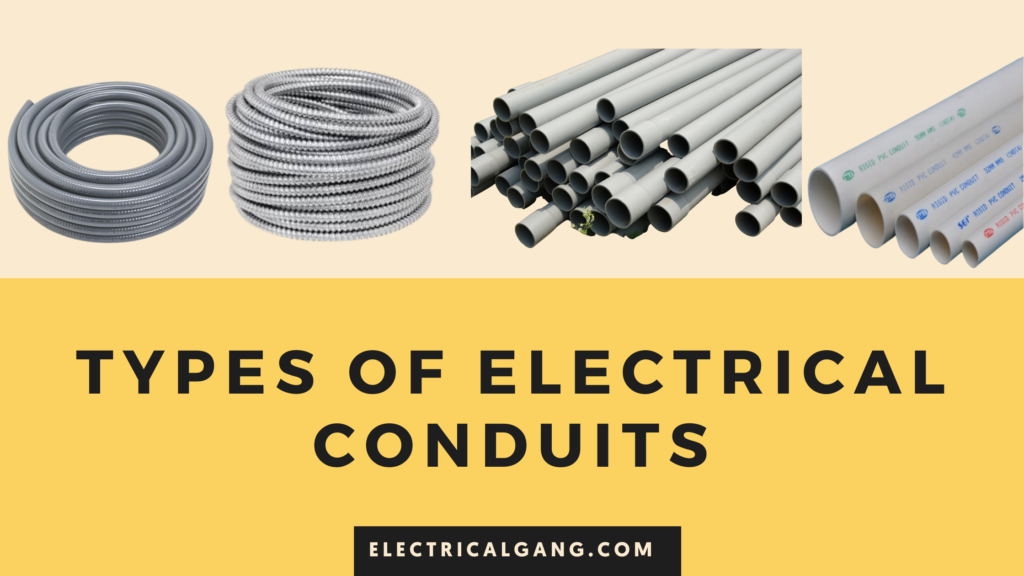
When an electrician or engineer designs wiring at home, he or she first decides what type of wiring to do. Choosing the right type of wiring makes any difficult task easier. Choosing the right electrical conduit is essential in the work of wiring.
The use of this conduit gives the wire a proper passage and protects it from damage from the outside environment for a long time. So today, we will see in our today’s article what is Electrical Conduit and what its types are, as we will discuss in detail today.
What is Electrical Conduit?

A Conduit made of plastic or metal inside which electrical wire runs smoothly. This is called an electrical conduit. The open wall from the outside is always found in the open environment, which protects the cable. It is used for unfinished places such as attics, crawlspaces, basements, and exterior mounts.
At a glance, this conduit looks like an armored cable. Like this Electrical Conduit, the insulated and lost individual wires are enclosed in an armored cable. This cable is used for the AC system, and this is used for open areas. Conduits are commonly used as a term to describe a system that has a series of electrical conductors.
The following are the reasons why duct systems are specially installed:
- Connect the part of the conduit accordingly.
- To act as a bridge outlet for the installed conductor.
- Provide cavities, especially for making taps and pieces in conductors.
- To provide taps, especially for branch tube runs.
- To make a 90-degree bend for the run of the hose.
- To provide access for the conductor in terms of future system and maintenance system.
- Act as mounting outlets for lighting fixtures and wiring devices.
Suggested Read: What is 2 Way Switch | 2 Way Switch Wiring
Types of Electrical Conduits:
A conduit system is generally classified on the material used to make mechanical inertia, tubing, and wall thickness. The material is selected for corrosion resistance and automatic protection after taking into account the factor.
In unsafe areas where prior approval is required, it is necessary to clearly follow some special guidelines for wiring equipment. The following are the types of conduits for residential and commercial lighting.
| Sr. No | Types of Electrical Conduits |
| 1. | Electrical Metallic Tubing (EMT) |
| 2. | Rigid Metal Conduit (RMC) |
| 3. | Intermediate Metal Conduit (IMC) |
| 4. | Flexible Metal Conduit (FMC) |
| 5. | Liquid-tight Flexible Metal (LFMC) |
| 6. | Electrical Non-Metallic Tubing- (ENT) |
| 7. | Rigid PVC Conduit |
#1. Electrical Metallic Tubing (EMT):
Electrical Metallic Tubing (EMT) is a common example of an unbending conduit, which is usually made of galvanized steel. Or it can be made of aluminum. This tube is commonly described as a thin-walled conduit as it is thinner and lighter than RMC. It can also be rigid, but it can be easily bent using a tool called a tube bender.
EMT is installed with fittings and couplings that are completely protected by compression-type fasteners or setscrew. The tubing itself is not threaded like IMC or RMC. It includes 1 to 1.5 inches in standard size available for EMT. Exposed indoor wiring is where EMT is commonly used. Because it often runs in light commercial or residential construction. That is why it is just as important to assemble it with special water-tight fittings.
#2. Rigid Metal Conduit (RMC):
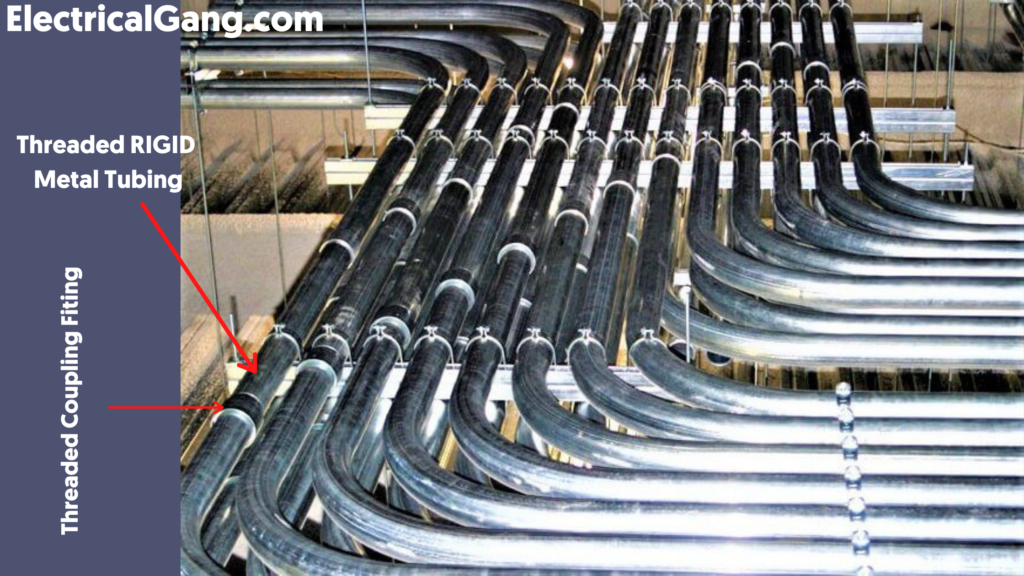
RMC stands for Hard Metal Conduit Heavyweight Galvanized Steel, which is installed using threaded fittings. Commonly taken in outdoor use to provide damage and protection. It is also important to provide structural support, especially for electrical panels, cables, and other equipment. RMC is only available for sale in lengths of 10 to 20 feet. And there must be threads on both ends of it.
This conduit is considered to be one of the most expensive alternatives for electrical wiring on the market. However, it does offer added power and durability, which is a huge plus.
Suggested Read: What Is an Electrical Resistor? | Types of Resistors | Resistors Color Code Calculation
#3. Intermediate Metal Conduit (IMC):
It is known from its name that the wall of this conduit is thinner than RMC and thicker than EMT. Similarly, the weight of this conduit also comes between RMC and EMT. This metal conductor is threadable but can also be un-threaded and can be used with clamp-type fittings. IMCs are usually made of steel and can also be coated.
#4. Flexible Metal Conduit (FMC):
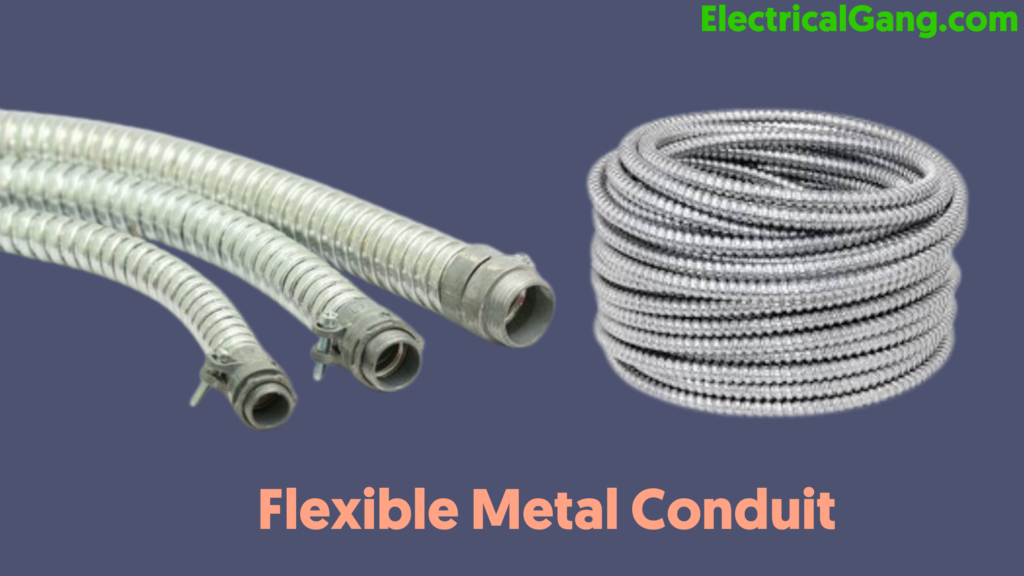
This conduit is also known as “greenfield,” which is taken from the name of the inventor. It has a spiral construction which makes it extremely flexible. The flexibility of the FMC makes it acceptable through walls and even other structures. Standard FMCs are commonly used for dry indoor locations, often only for short periods.
Suggested Read: What Is a Terminal Block? | Types of Terminal Blocks | Advantages of Terminal Blocks
The FMC is always a great option for many areas that require close quarters and a hard turn, making it difficult to divert regular conduits later. Lights, attic vents, and water heaters are common examples of basic flexible conduit installations.
#5. Liquid-tight Flexible Metal (LFMC):

LFMC, or liquid-tight flexible metal conduit, is a special type of flexible metal conduit that is used for the required seal fitting and includes a plastic coating. The parts that make up the entire LFMC are bound with water. This metal electrical conduit is used for equipment with the outdoor unit for AC.
#6. Electrical Non-Metallic Tubing-(ENT):
ENT is a thin-walled corrugated conduit that is flexible. It can be bent even without the aid of a special device. Don’t turn it around, though. This is easier to install than an RNC as it can be rotated around the barrier without cutting or welding. Special ENT connectors are used – these are usually snap-in connections and are not watertight.
Liquid-tight flexible nonmetallic condensate (LFNC) is also available for use where the umbilical cord will be subjected to moisture.
#7. Rigid PVC Conduit:
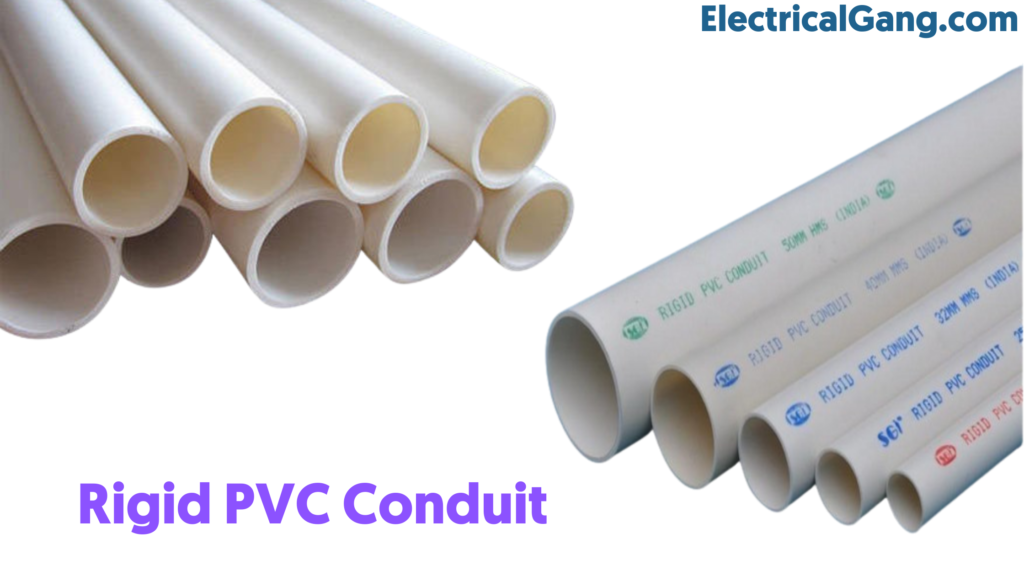
Rigid polyvinyl chloride (PVC) is similar to plastic plumbing pipes. And it is installed with plastic fittings, which are glued. It can be folded after heating in a portable heater box. Because the conduit tubing and fittings are glued together, the conduit assembly can be watertight. PVC, in many uses, makes it suitable for burial directly in the ground. It is also allowed in rusty environments.
Most Commonly Asked Questions:
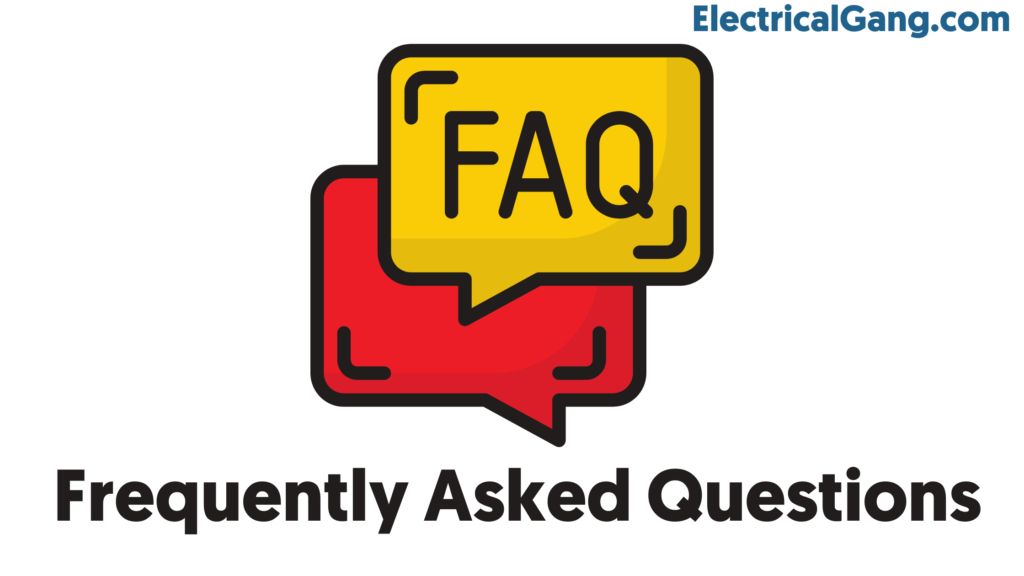
What are the seven types of electric conduit?
- Electrical Metallic Tubing (EMT).
- Electrical Nonmetallic Tubing (ENMT).
- Rigid Metal Conduit (RMC).
- Liquid-tight Flexible Metal (LFMC).
- Intermediate Metallic Conduit (IMC).
- Flexible Metal Conduit (FMC).
- Rigid PVC Conduit.
What are the different types of conduit?
The following types of conduit are generally used for residential and commercial lighting.
- Electrical Metallic Tubing (EMT).
- Rigid Metal Conduit (RMC).
- Intermediate Metal Conduit (IMC).
- Flexible Metal Conduit (FMC).
- Liquid-tight Flexible Metal (LFMC).
- Electrical Non-Metallic Tubing- ENT.
- Rigid PVC Conduit.
Should I use metal or plastic conduit?
PVC is an excellent corrosion-resistant material and remains strong even in alkaline environments and saltwater and chemical processing. The disadvantage of PVC is that it does not have grounding capabilities, nor is it a metal conduit. To prevent this, every electrician uses an additional grounding conductor in all PVC conduits.
What are the two types of conduit?
Electrical Conduit Types
- Rigid Metal Conduit (RMC).
- Electrical Metallic Tubing (EMT).
- Intermediate Metal Conduit (IMC).
- Flexible Metal Conduit (FMC).
What are the three types of wires?
Three types of wire are used:
- Live wire (red color).
- Neutral wire (black color).
- Earth wire (green).
Electrical Conduit Types:
| Sr. No | Types of Electrical Conduits |
| 1. | Electrical Metallic Tubing (EMT) |
| 2. | Rigid Metal Conduit (RMC) |
| 3. | Intermediate Metal Conduit (IMC) |
| 4. | Flexible Metal Conduit (FMC) |
| 5. | Liquid-tight Flexible Metal (LFMC) |
| 6. | Electrical Non-Metallic Tubing- (ENT) |
| 7. | Rigid PVC Conduit |
Types of PVC Conduit:
| Sr. No. | Types of PVC Conduit |
| 1 | Schedule 40 PVC Pipe |
| 2 | Schedule 80 PVC Pipe |
| 3 | PVC Utility Duct |
| 4 | Flexible Electrical Conduit |
| 5 | PVC Horizontal Boring Drilling Conduit |
Types of Conduit Wiring:
| Sr. No. | Types of Conduit Wiring |
| 1 | Rigid Metal Conduit |
| 2 | Intermediate Metal Conduit |
| 3 | Electrical Metallic Tubing |
| 4 | Flexible Metal Conduit |
| 5 | Liquid-Tight Flexible Metal Conduit |
| 6 | Electrical Non-Metallic Tubing |
| 7 | Rigid PVC Conduit |
Like this post? Could you share it with your friends?
Suggested Read –